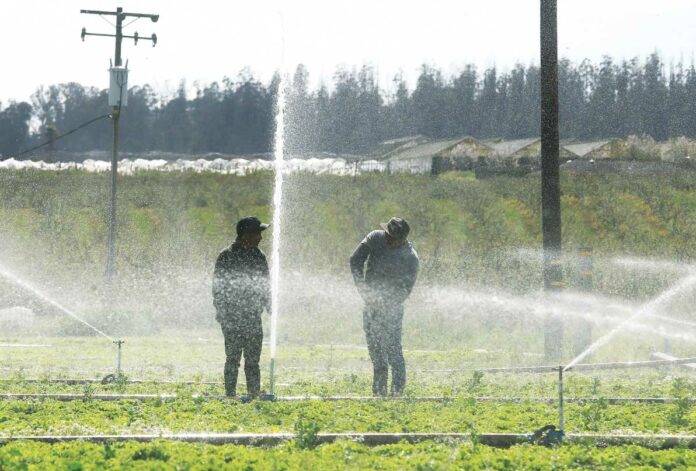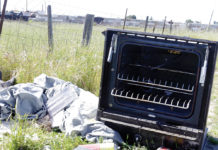
PAJARO—Pajaro/Sunny Mesa Community Services District, the agency that provides water to the Pajaro area, has lifted a do-not-drink order that came in the wake of the March 11 flood.
The April 7 decision came nearly a month after the Pajaro River levee broke and released torrents of water into the town of Pajaro and surrounding farmland, damaging and destroying hundreds of homes and businesses.
The event rendered the water system unusable, and when water began flowing to residences and businesses, the District feared that contaminants from nearby farm fields and other sources may have leached into the water.
No such contaminants were ever found, says Operations Manager Judy Vazquez-Varela. The order, she says, came out of an abundance of caution.
The water has tested negative for bacteria and meets standards for minerals such as iron and manganese, as well as dozens of pesticides, herbicides and other chemicals.
Still, employees cleaned, repaired and replaced defective equipment, as well as flushed and disinfected the distribution system, Vazquez-Varela says.
“In this situation it was really important to get that precaution out there, because we were not sure if any of the floodwater was in our wells,” she says.
Other areas impacted
With hundreds of people still unable to return to their damaged homes—or return to the fields in which they work—there is no question that Pajaro bore the brunt of the storms and flooding.
But there were impacts throughout the region.
Rising waters on March 10 destroyed a bridge leading to a small neighborhood in the hills above Soquel, which severed a pipeline bringing water there. That was repaired within days.
The Santa Cruz Water Department (SCWD), which draws its water from the San Lorenzo River during the winter, repaired a broken pipeline that supplies water from the Loch Lomond Reservoir to the Graham Hill Water Treatment Plant.
The damage was a concern for the Department, which serves some 98,000 customers and processes 6-8 million gallons of water per day.
SCWD also contended with having to treat water made murky by the rains.
In early April, Soquel Creek Water District repaired a damaged pipeline that brings water from Loch Lomond—the City’s primary drinking water source—to the Graham Hill Water Treatment Plant.
The underground pipelines of Pajaro Valley Water Management Agency, which serves the Watsonville area just to the north, were unaffected, says General Manager Brian Lockwood.
Workers are still evaluating the turnouts that bring water to farm fields, some of which are still flooded, Lockwood says.
The Agency will also continue to monitor water quality, he says.
Looking to the future
Lockwood says that the heavy rainfall has been good news for the drought-stricken region, bringing much-needed moisture to farms. This has meant less overall water use this year.
The billing cycle from December–February 2022 showed 5,342 acre-feet used. This year’s number was 2,845, Lockwood says.
A term commonly used when describing large water supplies, an acre-foot is about 326,000 gallons.
“Rainfall is doing its job,” Lockwood says. “Farmers are not needing to pump as much water.”
Still, as the rains appear to be over for the year, water resources managers throughout the county have a message for the community: the drought is not over, and everyone should still have conservation in mind.
“With climate change, we can no longer predict what the next year is going to hold,” says Eileen Cross, spokeswoman for the Santa Cruz Water Department. “So it behooves all of us to use water efficiently.”
Groundwater shortages still an issue
While Santa Cruz has enough water in the Ben Lomond reservoir for roughly one year, most of the rest of the county relies on groundwater.
But years of drought conditions—and of overdraft from the groundwater basins—have drawn salty seawater closer to the shoreline, where it threatens to intrude into the freshwater aquifers.
That would decimate the freshwater wells, says Ron Duncan, general manager of Soquel Creek Water District.
An aerial survey in 2017 by a Danish company showed that the seawater intrusion has reached the shoreline, a revelation Duncan called “jaw-dropping.”
That problem is worsened by a lack of rainfall that would seep below ground and recharge the aquifers.
This has given the region the unfortunate distinction of being critically overdrafted, along with 20 of the state’s 500 basins, Duncan says.
Reversing this would take decades, he says.
The type of high-intensity, short-duration storms that came this year, he says, are less helpful because most of that water typically drains quickly away.
Even in ideal rainfall conditions, just 7% of rainwater infiltrates back into aquifers.
“We don’t get much recharge to our aquifers unless it rains at least around a normal rainfall,” he says. “We need a sweet spot, really the opposite of what we’re getting.”
The message, then, is to continue water conservation efforts.
Duncan says that county residents have done well with conservation, averaging 50 gallons per day, compared to 80 gallons statewide.
“We are using the same amount of water now than we were using in the early ‘70s,” he says. “People have been heroes, but here’s the catch: it’s still not enough.”
But more efforts are needed to help slow or stop seawater from infiltrating freshwater wells, Duncan says.
Hope on the horizon
PVWMA is now gearing up to start the College Lake Integrated Resources Management Project, which would use the naturally-occurring lake—which historically has been drained in the summer to make way for crops—as a permanent source to supply 1,700 acre-feet of water to local growers.
The $68 million project includes a weir structure, a treatment plant and a six-mile pipeline that will convey treated water from College Lake to connect to the coastal distribution system.
The purpose of that project, Lockwood says, is to further reduce groundwater extraction to help close the gap in the critically overdrafted basin and stop seawater intrusion.
Construction is expected to begin in the summer.
In Mid-County, SCWD is looking to take a bite out of groundwater overdraft and seawater intrusion with its massive Pure Water Soquel project, which would take 25% of the water coming from its treatment plant—which normally would flow to the ocean, and use to recharge the aquifer.
The project was designed so it can be doubled in scope, if another water agency wants to join in the future, Duncan says.
Work is underway for the $145 million project.












